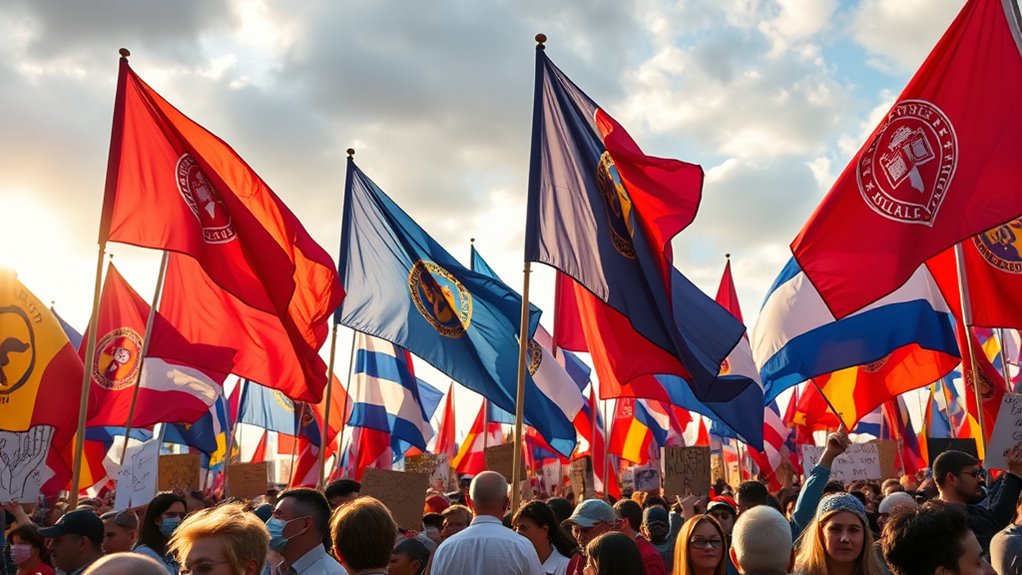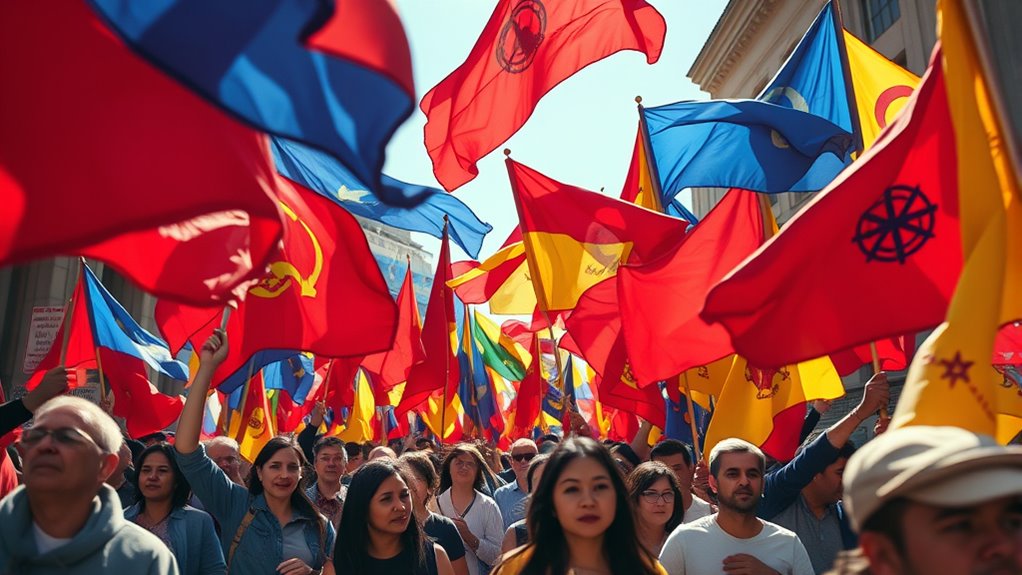Flags are powerful tools that symbolize a movement’s values, rally supporters, and communicate messages beyond words. Their colors, symbols, and designs evoke emotions, foster unity, and inspire collective action. During revolutions, flags represent hope, resistance, and shared purpose, helping individuals feel connected to something bigger. Recognizing these symbols deepens your understanding of social change. If you look closer, you’ll uncover the meaningful stories behind each flag and what they stand for.
Key Takeaways
- Colors on flags symbolize core values like freedom, justice, and resistance, reinforcing movement identities.
- Specific colors are associated with particular movements, such as red for revolution and black for anarchism.
- Flag colors serve as visual cues that unify supporters and communicate collective goals.
- The choice of colors enhances emotional impact, inspiring hope and resilience during social upheavals.
- Recognizing color symbolism in flags helps understand the underlying message and significance of revolutionary movements.

Have you ever wondered how flags symbolize movements and unify people across the world? Flags are more than just pieces of fabric with colors and shapes; they serve as powerful symbols that embody the essence of a movement or a cause. This is where flag symbolism comes into play. Every color, emblem, and pattern on a flag is carefully chosen to represent core values and shared ideals. When a movement adopts a flag, it creates a visual identity that members can rally around, offering a sense of belonging and purpose. The flag becomes a rallying point, a symbol that communicates the movement’s goals without words. It’s a way for individuals to see themselves as part of something bigger, something meaningful they can identify with instantly. Flag symbolism isn’t just about aesthetics; it’s about conveying messages quickly and effectively, especially during protests, marches, or public gatherings. When you see a flag waving in the wind, you recognize its significance—it’s a visual shorthand for collective aspirations and struggles. Recognizing flag symbolism helps us understand the deeper meaning behind these visual representations.
Movement symbolism is closely intertwined with flag symbolism because both serve to reinforce identity and unity. Movements often rely on visual symbols like flags to emphasize their message and galvanize support. For example, during revolutions or social uprisings, flags are raised to symbolize resistance and hope. They become a visual banner under which people gather, reinforcing the shared purpose of the movement. The colors and symbols chosen often reflect the movement’s core values—justice, freedom, equality, or independence. These visual cues help transcend language barriers and cultural differences, making the message accessible to everyone. When you see a flag associated with a cause, you instantly understand its significance, even if you’re unfamiliar with the specific history behind it. It’s a universal language of sorts, expressing collective emotion and intent. The choice of colors and designs on a flag can also evoke emotional responses, amplifying the movement’s message.
The power of flag symbolism lies in its ability to evoke emotional responses. People rally around flags because they represent a common struggle or aspiration. When a movement’s flag is displayed prominently, it reminds supporters of their shared commitment. It becomes a symbol of perseverance and hope amid adversity. As you observe a movement’s flag waving proudly, you recognize that it’s more than just fabric—it’s a visual testament to resilience and solidarity. Overall, flags are essential tools in movement symbolism because they encapsulate complex ideas into a simple, recognizable image. They unify individuals, inspire action, and communicate messages that resonate beyond words, making them crucial in the ongoing story of social and political change.
Frequently Asked Questions
How Do Colors Influence Public Perception During Protests?
Colors greatly influence your perception during protests by leveraging symbolic color associations and cultural color interpretations. When you see bold, specific colors, they evoke emotions and messages—like red for urgency or passion, or green for hope and renewal. These colors shape your understanding and reactions, making the movement more memorable and impactful. By using meaningful colors, protesters can communicate their goals powerfully without words, guiding public perception effectively.
Are There Universal Meanings Assigned to Specific Flag Colors?
Imagine a palette where each color whispers its story—red as passion, white as peace. You should know, there’s no universal code for these hues; cultural symbolism and historical associations color their meanings. Like a chameleon, a color’s message shifts with context and culture, so you can’t rely solely on a single hue to convey a universal message. Instead, look at the entire flag’s story to understand its true significance.
How Do Governments Attempt to Suppress Revolutionary Symbols?
Governments often suppress revolutionary symbols through censorship tactics, banning flags or imagery associated with dissent. They may confiscate or destroy flags, arrest individuals displaying such symbols, and restrict access to related materials. Propaganda strategies are also used to discredit revolutionary movements, painting them as threats to stability. By controlling information and visual symbols, authorities aim to diminish their impact and discourage public support, effectively silencing revolutionary expressions.
Can Flag Colors Change Over Time Within Social Movements?
Yes, flag colors can change over time within social movements. You might see evolving symbolism as groups undergo cultural reinterpretation, adjusting their flags to reflect new goals or identities. These changes help keep the movement relevant and resonate with current struggles. By evolving their symbols, movements strengthen their identity and communicate their message more effectively, showing that symbols are dynamic and can adapt to shifting cultural and political landscapes.
What Role Do Design Elements Play Alongside Colors in Flags?
Design elements like symbols and flag shapes play a vital role alongside colors in flags. You should consider symbolism in emblems, which convey deeper meanings and values of the movement. Additionally, the shape of the flag itself can hold significance, representing unity or a specific region. These elements work together with colors to create a powerful visual identity, strengthening the message and impact of the movement you’re supporting.
Conclusion
Remember, a flag is more than just cloth; it’s a symbol of hope and change. As you see colors wave, know they represent dreams, struggles, and revolutions. When you stand for a cause, you’re part of a movement that’s bigger than yourself. Like the saying goes, “United we stand, divided we fall.” So, hold your flag high, and let your actions speak louder than words in shaping a better future.









